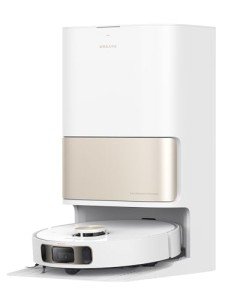The Evolution of Robot Hoovers: Revolutionizing Home Cleaning
Robot hoovers, likewise referred to as robotic vacuum, have actually changed how individuals approach family cleaning jobs. At first presented in the late 1990s, these autonomous machines have developed rapidly due to advancements in technology, expert system, and machine learning. Today, they are geared up with a variety of functions that make them extremely reliable in maintaining cleanliness in living areas. This post checks out the history, operating, benefits, and future of robot hoovers.
The History of Robot Hoovers
The idea of robotic vacuums go back to the 1970s, but it wasn't till the launch of the Roomba by iRobot in 2002 that they gained traditional attention. The Roomba was designed to instantly navigate different surface areas, avoiding challenges while effectively cleaning floorings. Ever since, numerous considerable advancements have taken place, consisting of:
| Year | Development |
|---|---|
| 1996 | First prototype robotic vacuum developed by a Japanese business. |
| 2002 | iRobot launches the Roomba, mass popularizing robotic vacuums. |
| 2004 | Intro of the first Roomba with a dirt detection sensor. |
| 2011 | Release of designs with wireless capabilities and smart device combination. |
| 2020 | Advanced designs featuring AI, improved navigation systems, and mopping capabilities. |
How Robot Hoovers Work
Robot hoovers operate on a mix of sensing units, cams, and algorithms that enable them to clean effectively. Secret components of these devices include:
Sensors:
- Obstacle Avoidance Sensors: Detect walls, furnishings, and even stairs, avoiding accidents and falls.
- Dirt Detection Sensors: Identify areas that require more comprehensive cleaning.
Navigation:
- Gyroscopes: Help figure out the robot's orientation and motion.
- Electronic cameras and Lidar: Enable mapping of the home environment to produce optimal cleaning paths.
Cleaning Mechanisms:
- Vacuum Motors: Generate suction to get dirt and debris.
- Brush Rollers: Agitate dirt out of carpets for deeper cleaning.
Power Supply:
- Batteries: Rechargeable lithium-ion batteries provide the necessary power for extended cleaning cycles.
Interface:
- Mobile Apps and Smart Home Integration: Users can schedule cleansings, display performance, and control the robot remotely.
Benefits of Robot Hoovers
Robot hoovers provide numerous advantages, making them an enticing alternative for contemporary homes:
- Time-Saving: Automated cleaning permits users to focus on other jobs while the robot effectively cleans up floors.
- Convenience: Many models can be scheduled for cleaning sessions, ensuring that homes stay neat without manual effort.
- Accessibility: Ideal for individuals with mobility challenges or busy way of lives, enabling much easier home upkeep.
- Constant Cleaning: Regular, automated cleanings reduce the accumulation of dirt and allergens, adding to a much healthier living environment.
- Smart Technology: Integration with smart home systems allows for increased control and modification.
Limitations of Robot Hoovers
In spite of their benefits, robot hoovers include particular constraints:
- Navigation Challenges: They might have a hard time in cluttered areas or with certain floor types such as high-pile carpets.
- Battery Life: Most models require routine charging, which can restrict cleaning duration.
- Upkeep: Regular cleaning of filters, brushes, and clearing dust bins is required for optimal performance.
- Price: Advanced models can be costly compared to traditional vacuum cleaners.
The Future of Robot Hoovers
As innovation continues to progress, the future of robot hoovers looks promising. Expected improvements consist of:
- Improved AI: Enhanced algorithms will permit better item recognition and dynamic mapping of areas.
- Hybrid Models: Integration of vacuuming and mopping abilities in one gadget will supply a detailed cleaning service.
- Increased Autonomy: Future designs might navigate even the most complex environments without human intervention.
- Sustainability: Battery technology advancements will cause longer-lasting, more energy-efficient robots.
Regularly Asked Questions (FAQs)
1. Are robot hoovers efficient for family pet hair removal?
Yes, numerous robot hoovers are particularly designed to deal with pet hair with effective suction and specialized brushes that minimize tangling.
2. How do robotic vacuum cleaner deals navigate around furniture?
Robot hoovers use a mix of sensors and electronic cameras to discover obstacles, permitting them to navigate around furniture and avoid accidents.
3. Can robot hoovers tidy carpets?
Many modern-day robot hoovers are effective on both tough floors and carpets. It is recommended to examine the specifications of individual models for specific efficiency.
4. Do robot hoovers require shows?
Numerous robot hoovers feature user-friendly apps that allow owners to set schedules and tailor cleaning preferences, making programs simple.
5. How much do robot hoovers cost?
Costs for robot hoovers differ extensively, ranging from ₤ 200 to around ₤ 1,500, depending upon features and brand name.
Robot hoovers have come a long way given that their creation, using an efficient and hassle-free cleaning option for contemporary homes. Their increasing ability and intelligence make them a useful choice for individuals wanting to streamline their cleaning routines. As innovation continues to advance, robot hoovers will likely end up being much more capable, supplying additional features that accommodate the developing needs of users. Their journey from novelty to requirement underscores a fundamental shift in how society approaches home upkeep, marking a significant milestone in the intersection of technology and daily life.

